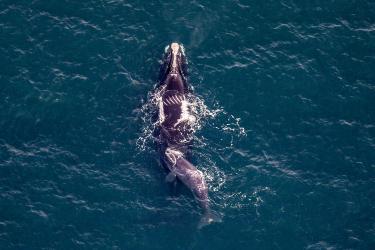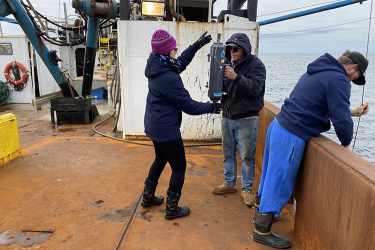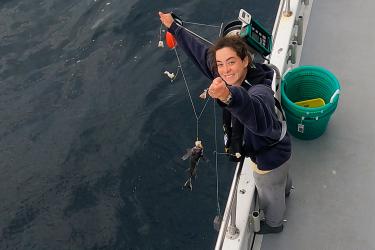After a very productive start to our bottom trawl survey, we’re back out on leg 3 with the goal of finishing the remaining stations on Georges Bank and in the Gulf of Maine. We sampled along the Northern Edge of Georges Bank. Along with some familiar fish such as haddock, winter flounder, and lobster, came the familiar (but not so pleasant) smells that we expect while sampling fish. Anyone who’s worked with this fish can tell you it has a very peculiar, fishy smell that seems to be unique to haddock.
The stomachs we sampled from this area were full of diverse prey items. For example, we found rock gunnels, scallop viscera, fish vertebrae, octopus, crabs, and arrow worms. It’s the stomachs with whole fish that cause us to pause before examining—that smell can hit you in the nose and stay for a while! You hold your breath, identify the fish, send it overboard, and rinse down the work station before moving on. The digested fish can spread all over.
One culprit of a rancid-smelling stomach was a sea raven that had recently eaten a large bony fish. We could identify it as a haddock from the otolith found in the remains. Otoliths are hard structures found near the haddock ear. These are shaped distinctively and are often used to identify a species and how old a particular individual is.
Another smelly stomach came from a goosefish with a partially digested skate inside. We weren’t sure if it was a little skate or winter skate , but we could clearly see the tail and wings. It’s so convenient when prey items still have identifiable features!
Both the goosefish and sea raven have extremely large mouths that allow them to consume very large prey. The goosefish has many large teeth at the opening and back of its mouth. They will easily eat a fish that is more than half their size, and won’t hesitate to bite down on your hand should you get too close!
But sometimes it’s the unpleasant smells that remind you of home. The ship can definitely feel like a second home—after being away for a year, it’s nice to finally be back.
Christine Kircun
On Leg 3, May 2021
Aboard the NOAA Ship Henry B. Bigelow






